[Re][기타]러시아 관광객이 찍은 북한 풍경
와니 | 2006-06-15 23:37:13
조회 5183 | 추천 2 | 다운로드 0
http://www.enlight.ru/camera/dprk/index_e.html작성자 : 와니
가능하다면 번역해서 올리고 싶었지만... 엄청난 양에 겁먹어 포기헜습니다.
>
>http://www.militaryphotos.net/forums/showthread.php?t=82755
A few more pictures taken by another russian tourist.
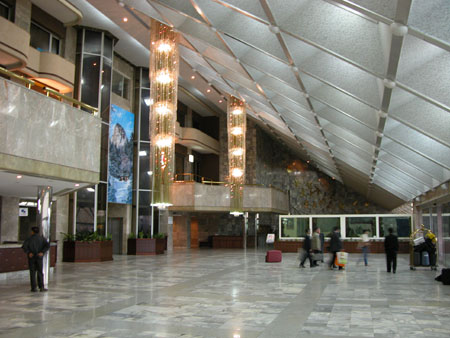
Hotel
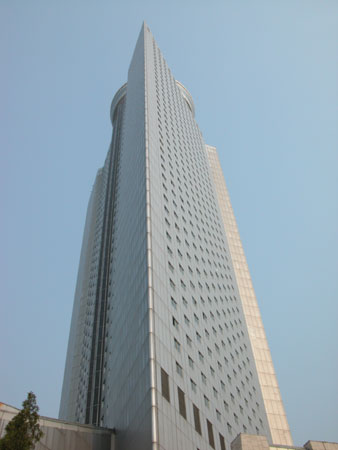
Another shot of the hotel
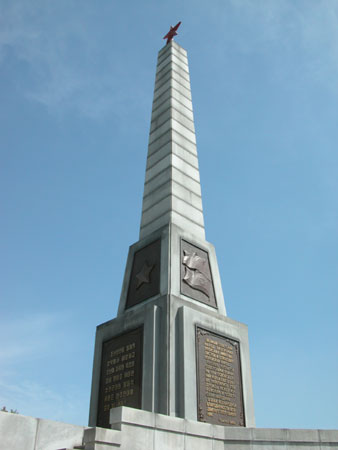
Monument to soiviet soldiers
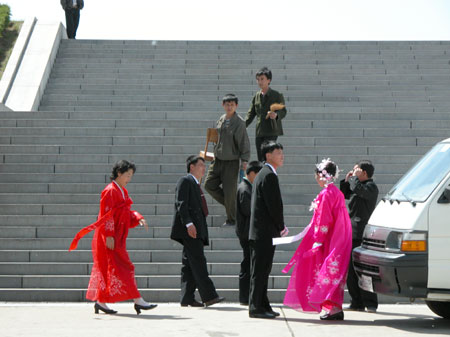
Wedding
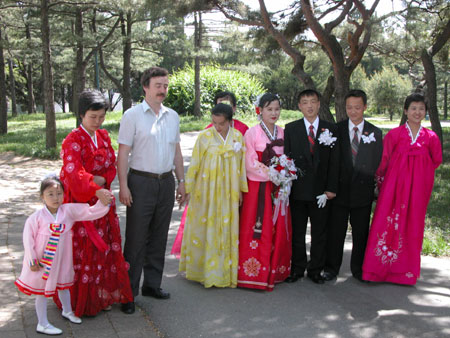
Another wedding and one of the tourists
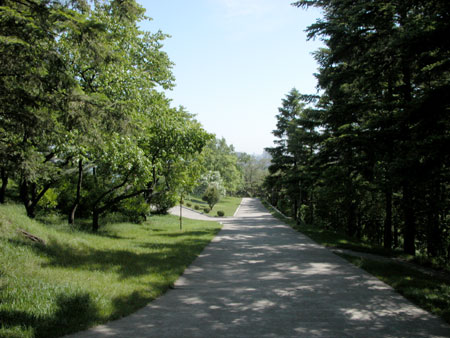
A park in Pyongyang
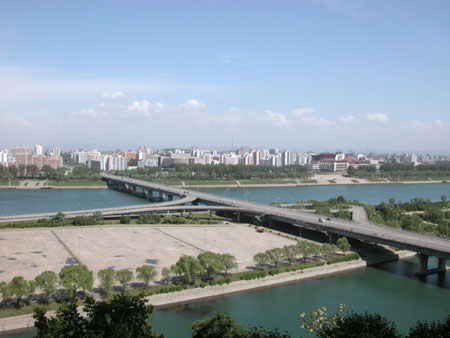
View of Pyongyang from Moran Hill
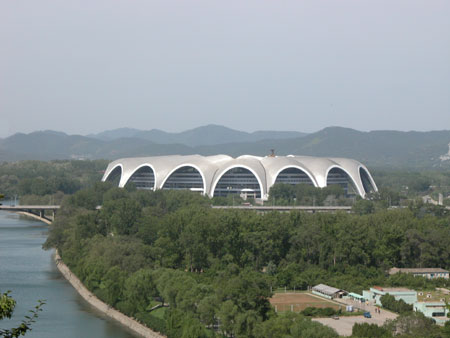
May 1st, stadium
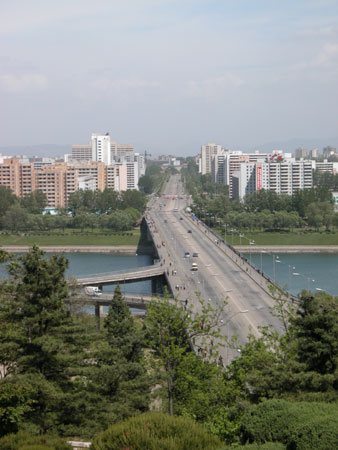
Bridge
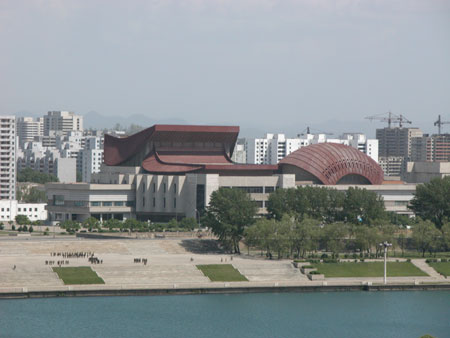
Central House of the Youth
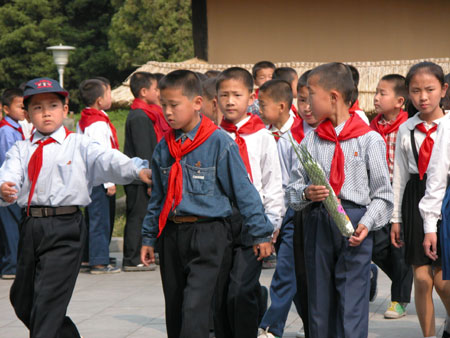
Pioneers
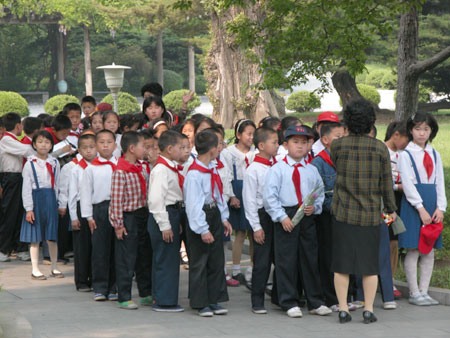
The School Uniform exists but its not toally respected
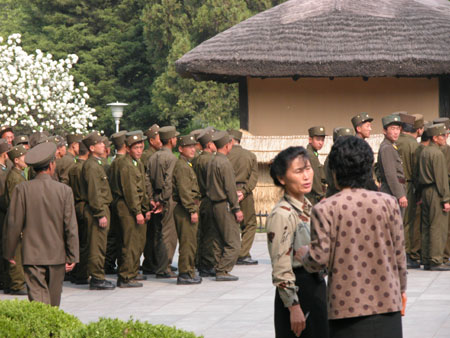
Soldiers, and they have to serve 6 years...
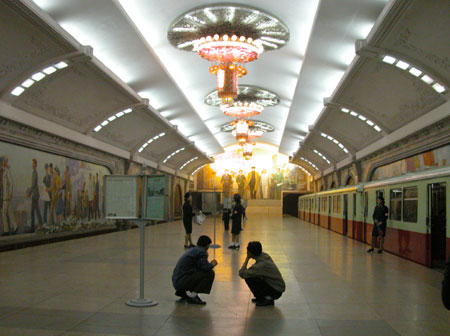
Favorite pose of koreans during a conversation
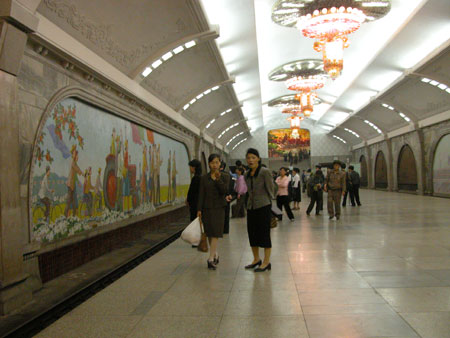
Apperently there is no etiquette in the subway, you don't h
ave to let people out before you get in.
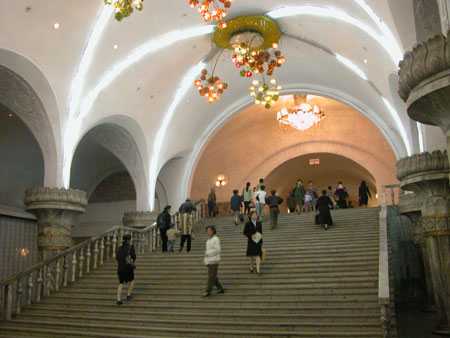
Another station
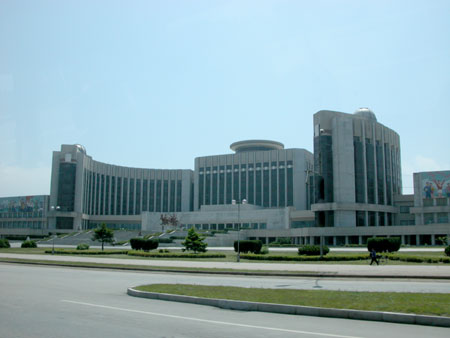
Pioneers and students palace
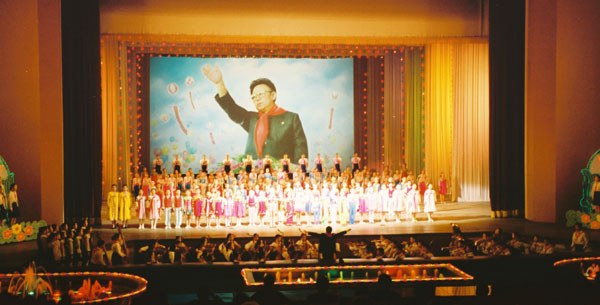
That famous concert
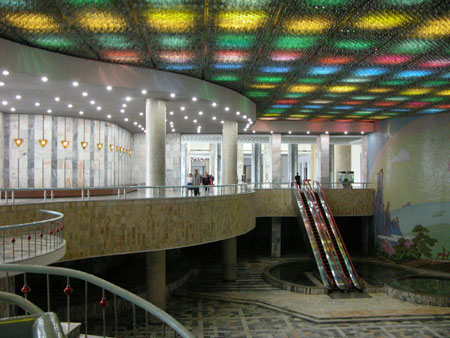
Probably that escalator that was turned on just for the visitors
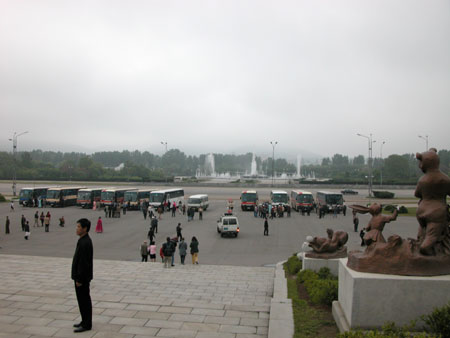
Tourists, there were a lot of europeans during the concert
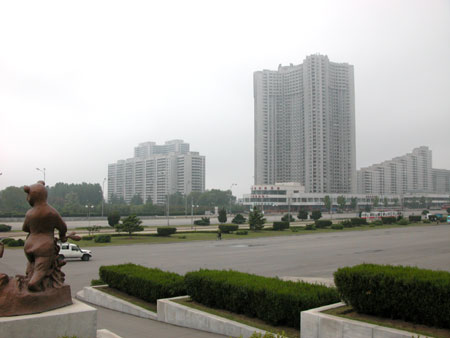
Buldings
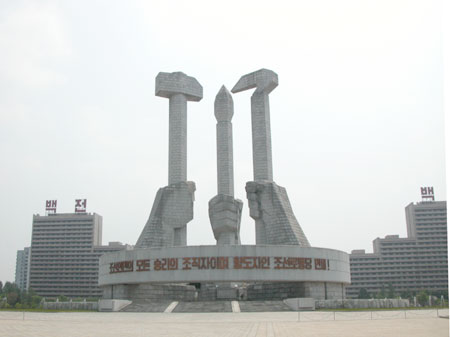
Monument of the foundation of the workers party ( Benz :P)
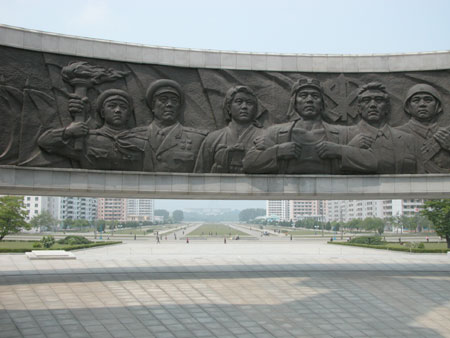
View from the center
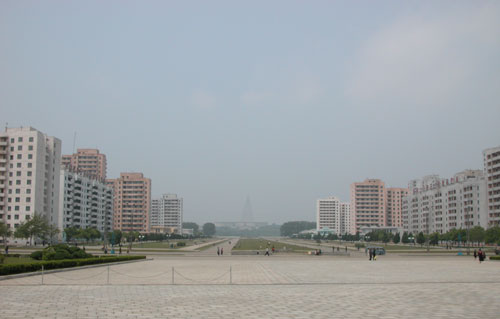
You can see the unfinished hotel, it's still unknown why they abandoned it , since other buldings were build
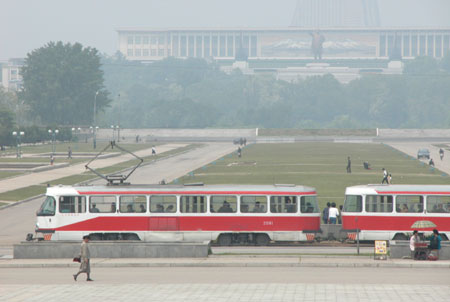
Czechoslovakian trams
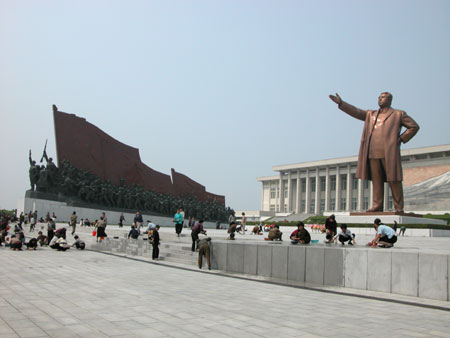
The super momument, everyone who comes to see it bows
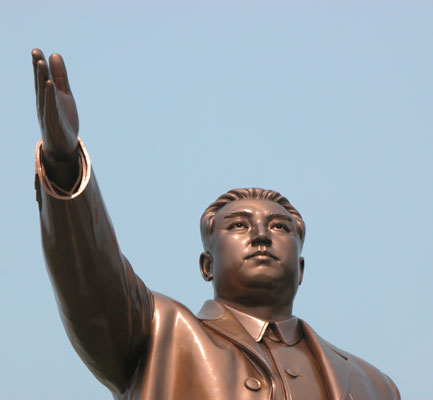
It's a mystery why it's so clean, also i guess that shot would be concidered illegal since you dont see the whole statue

Cleaning the square
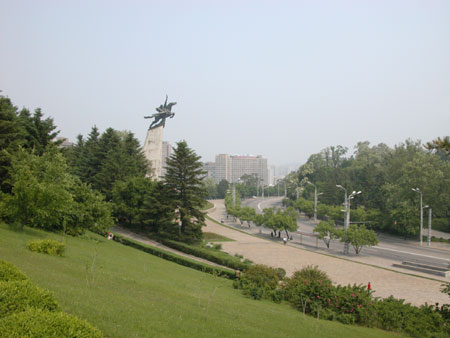
A street next to the Kim il Song monument

People's study palace
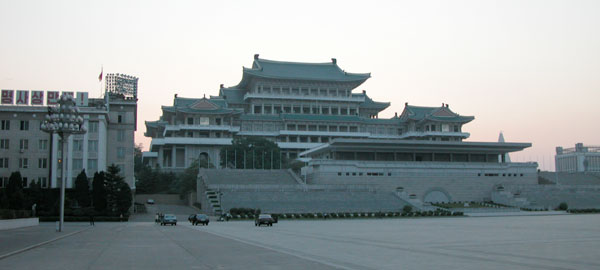
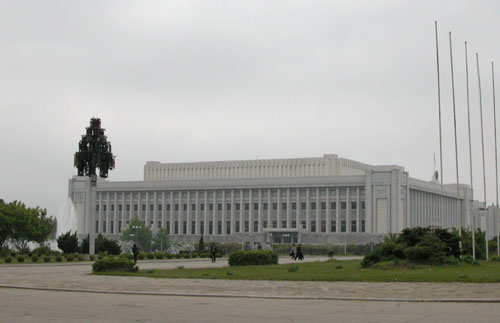
Congress palace i think
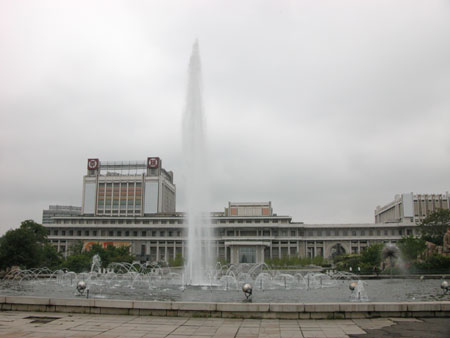
Theatre
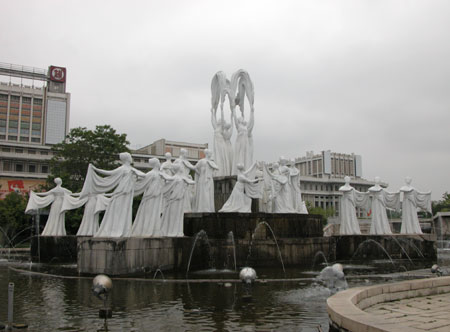
28 dancers sculpture
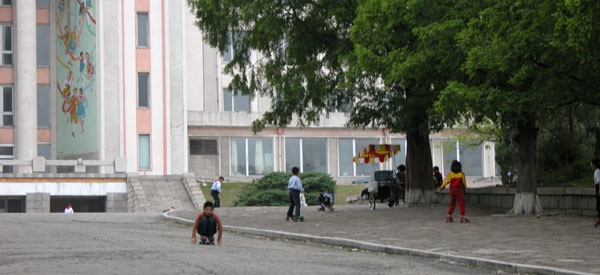
Kids on rollerskates
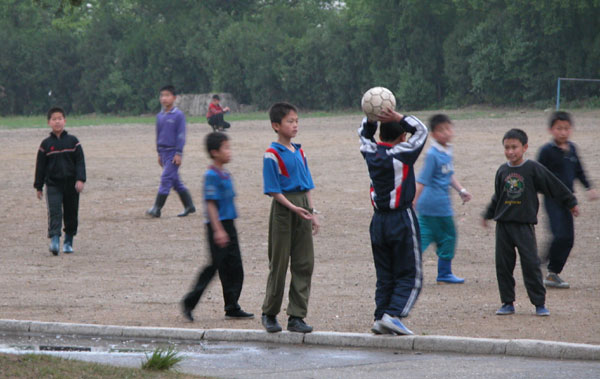
Kids
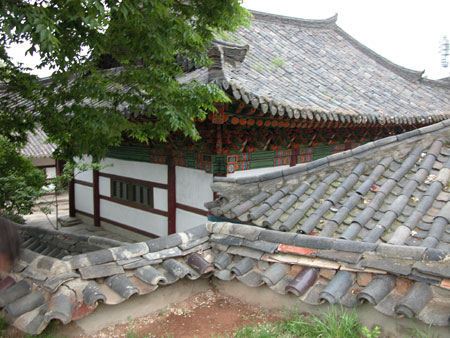
Old buddhist temple
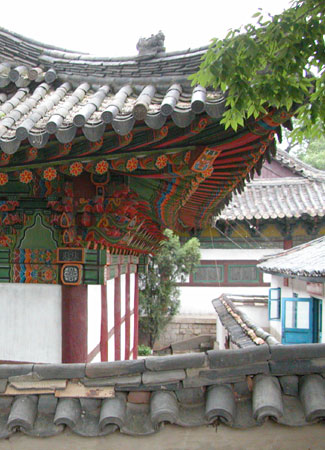
Apprerently there is also a protestant chrurch in Pyongyang
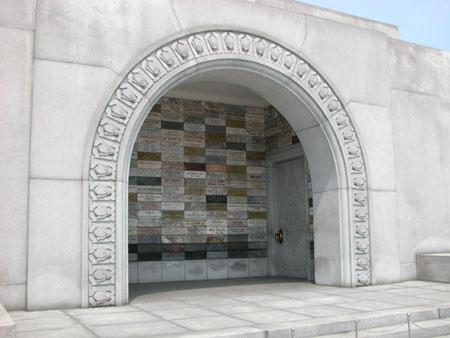
Marble slabs commemorating different organisations and people friendly to NK
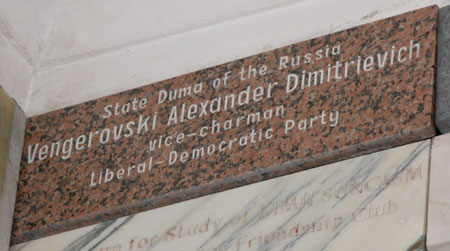
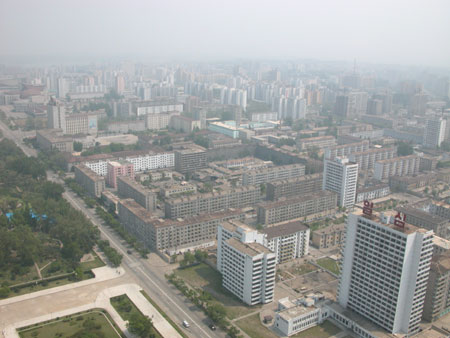
View from the Jurche monument ( the one that has dead birds :P)
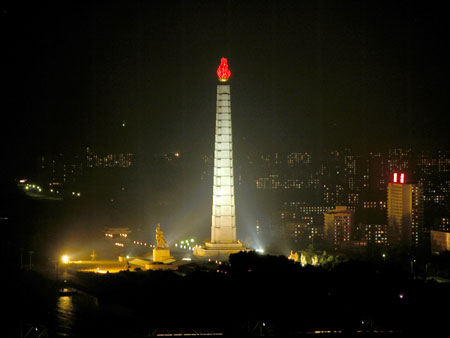
A night (before they turn off the light)
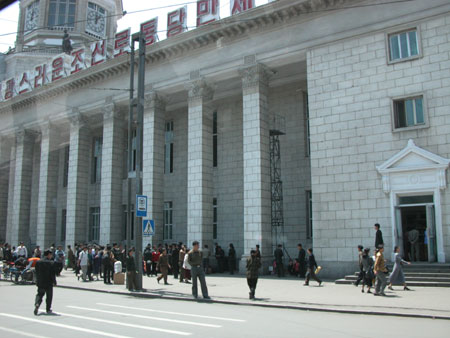
A street in Pyongyang
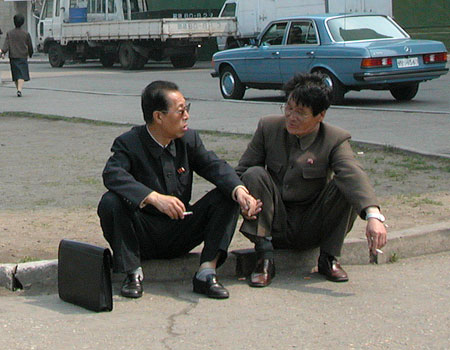
People and a BENZ!!!
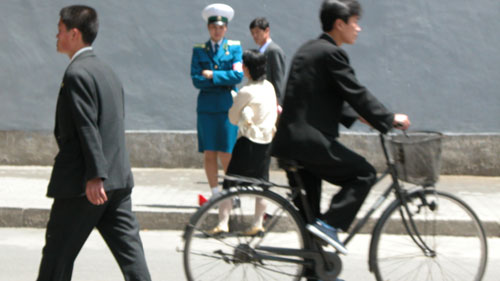
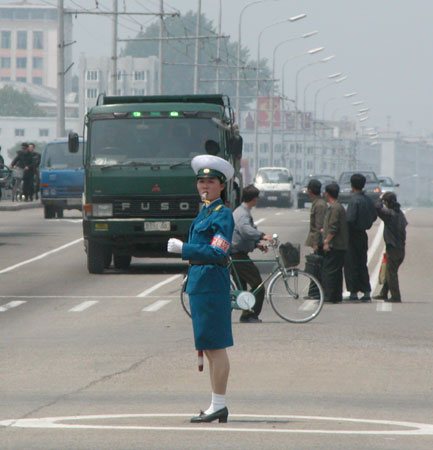
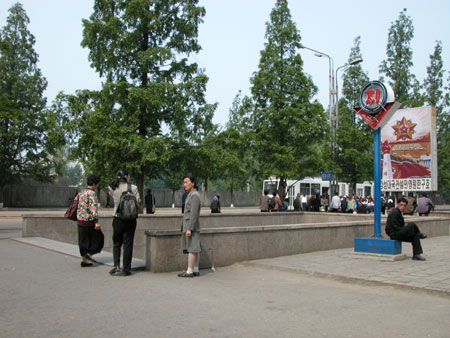
Underground crossing
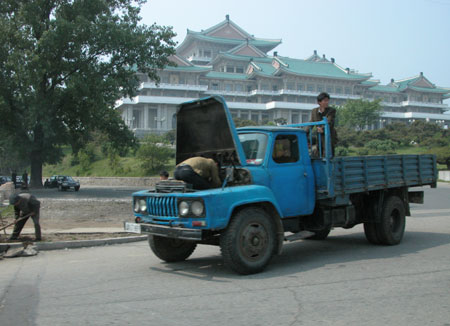
No one forbid him to take that picture
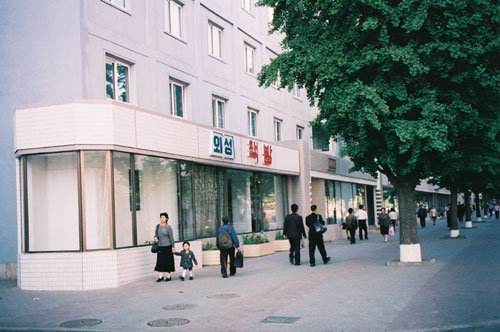
He said that people were curious as in " wow a white person"
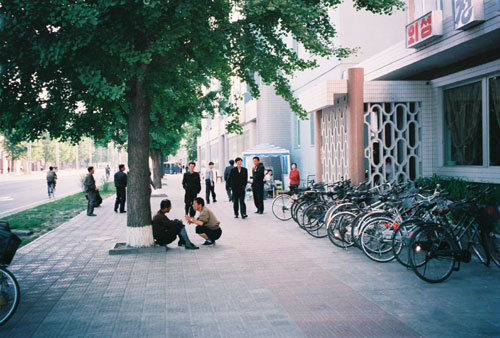
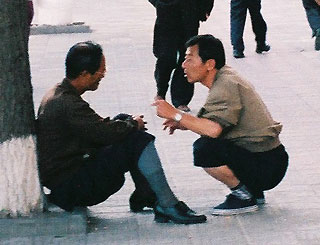
Nice socks
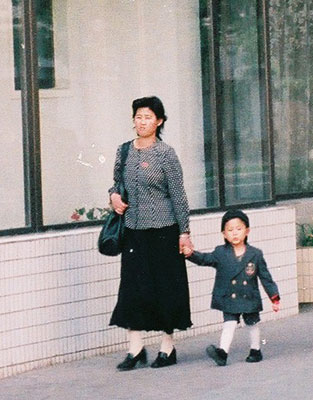
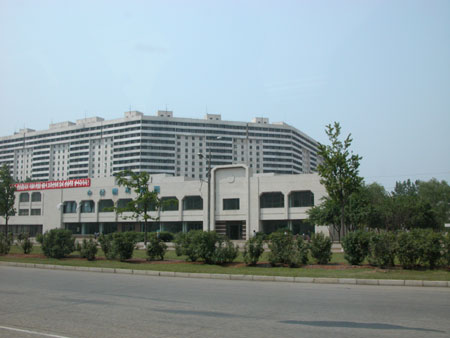
About the stores
We have visited a local department store. Our girls did not want to take us there ("We don't usually take foreigners to local stores"
As far as food, every thing is not so good (eggs, meat, and something else can only be bought with coupons), other consumer goods are easier to get. For the most part, the merchandise is imported (from China), and quite pricy. Roughly speaking, to buy a regular jacket, a simple Engineer or Interpreter will have to save money for a few months. Approximately the way it was in the Soviet Union.
The saleswomen are obviously different from those in the foreign currency stores (where girls are clearly selected by age, height, and attractiveness). Though, rudeness is apparently not acceptable in Korea, regardless of the status of the store.
The shoppers are common people - both workers and engineers and technical workers. They don't buy very much, mostly look and compare prices before their holiday shopping. In the musical instruments department, someone was playing a piano, put out for sale.
Needless to say, the people in this store were looking at us not even with astonishment and curiosity (like on the streets), but as if we were a hallucination
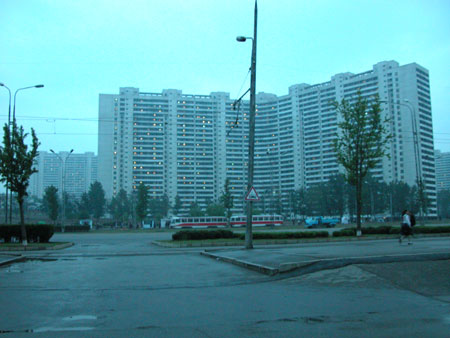
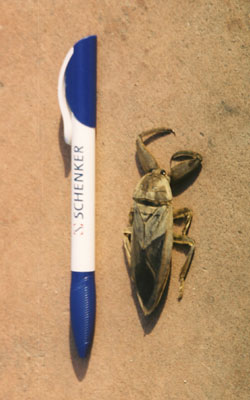
korean bug
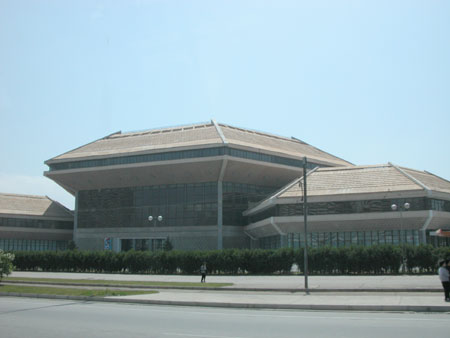
Pyongyang circus
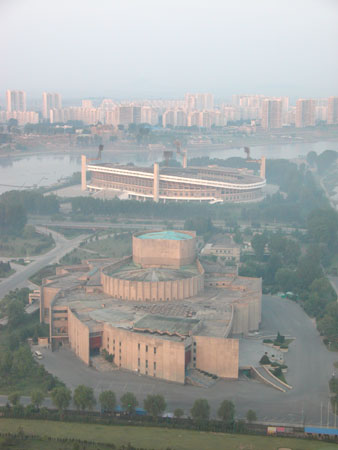
Movie theatre
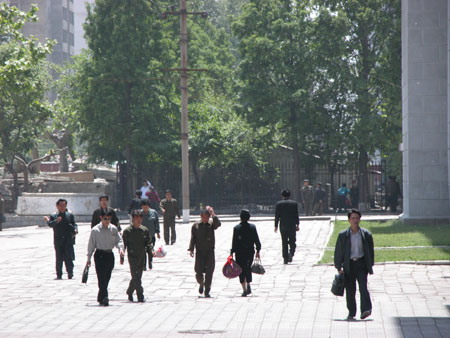
There was an interesting moment when Alexey had trouble falling asleep and went out of the hotel at 6 in the morning to some random neighborhood. No one stopped him.He walked for about three kilometers, and was finally stopped by a policeman, who asked him for identification (in Korean, naturally). Since, first of all he didn't have identification, and second he knew but a few words in Korean, they could not reach an understanding. A crowd gathered around them quickly (they don't meet foreigners in residential quarters very often
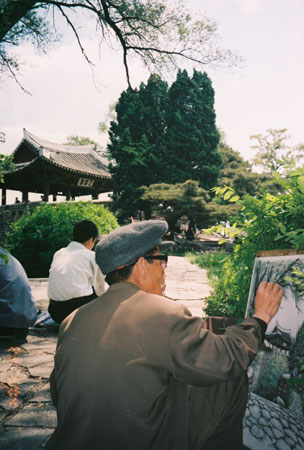
Painter in the park
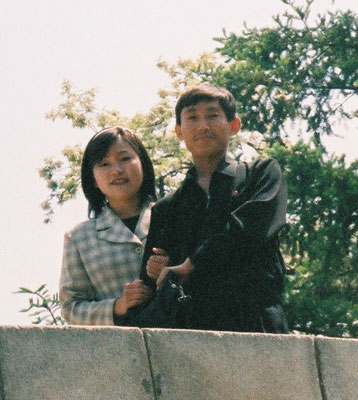
Curious people

Japanese tourists
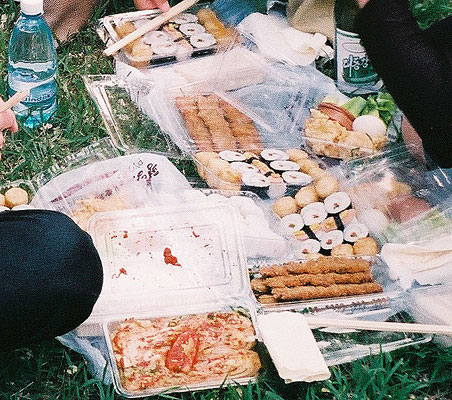
Food
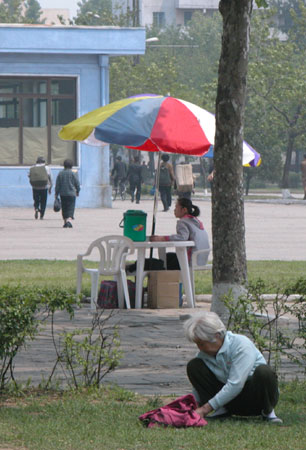
A quite common sight is a person or several people gathering seeds of some weed on the lawn. In the background - an ice cream sale.
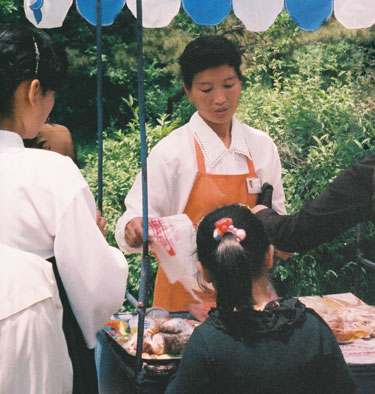
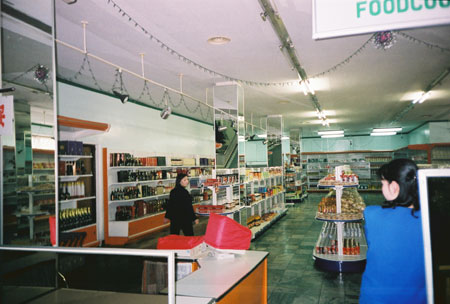
Foreign currency store.
In regards to North Korea, one can not talk about any freedom of speech. Apparently there hasn't been any political change; the government is still in control of the situation in the country.
However there have been economic changes. The foreign currency stores (in the picture) are more widespread. That is to say that (by hearsay) they existed here since the mid-70's, and locals were not denied access to them.
The selection in the stores is wide, especially when it comes to food. It's a little worse with the industrial goods. The modern electronics are pretty expansive (for instance, a SD/MMC card costs about twice as much as in St. Petersburg).
I saw some Koreans in the store (they were well to do of course), there are no noticeable checks or restrictions at the entrance.
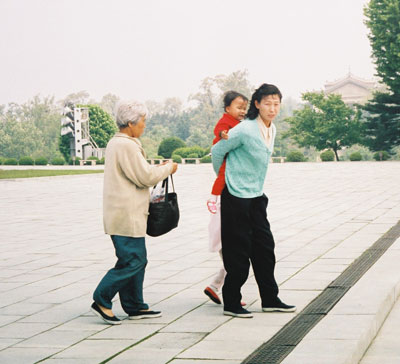
Now there are joint businesses with foreigners - restaurants. A restaurant can only be owned by a foreigner - for example Japanese (see a photo above, where a waitress is playing an instrument). The local population can work for a foreign owner, but can not own the restaurant.
Not a bad way to keep the economy under control.
In the picture: The Koreans are shy of carrying their babies behind their back sometimes. As I was told, the South Koreans do this also, however this is "countryside style". Also, I heard that as a result of being carried this way, children's legs can often get disfigured.
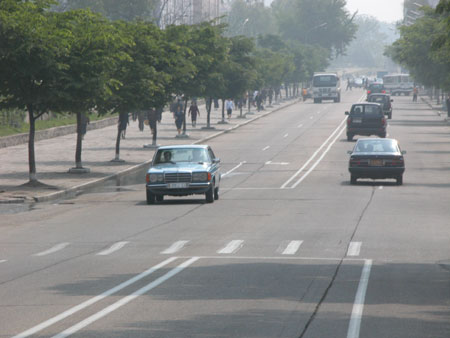
Also, there are cooperatives. In the North Korean version, a cooperative is a team, which produces some articles (for instance, collects and dries cochlea beer snack, or makes chewing gum), sells them, and splits up the profit equally among all the members. The types of business and products are limited, and a state license is required.
The result is approximately the same as in our country in the late 1980's: the selection in the cooperative stores is wider than in the state owned stores, but the prices are considerably higher.
The cooperative products are usually of a lower quality than those in the state owned stores (sometimes it's enough to look at the package to realize that).

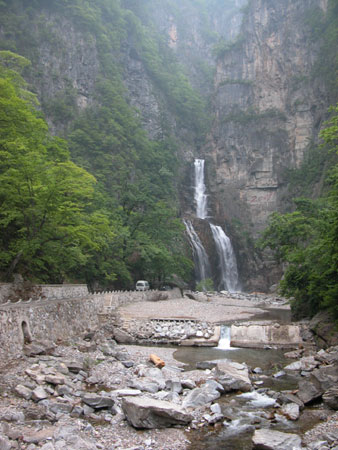
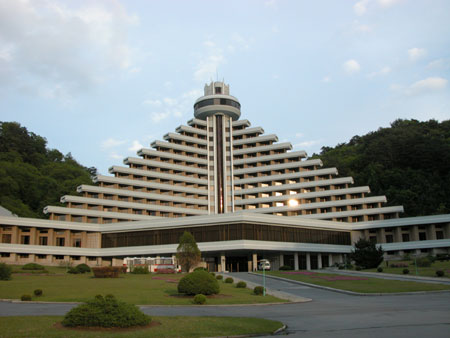
A short distance from the town is the Hyangsang Hotel where we stayed during our visit to Myohyang.
A revolving restaurant is at the top. It features very scenic views.
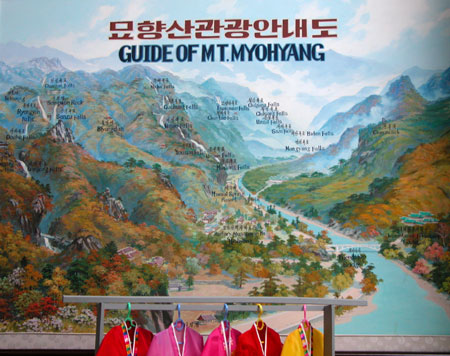
map in the hotel hall.
The main attraction in these mountains is the abundance of waterfalls.
The river you see here passes by the hotel and has the same name as the mountains - Myohyan
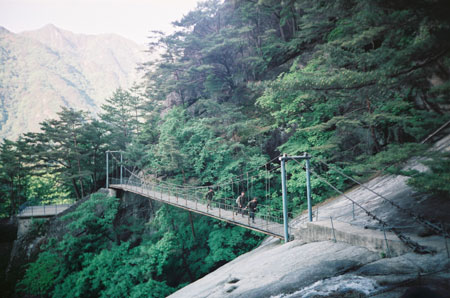
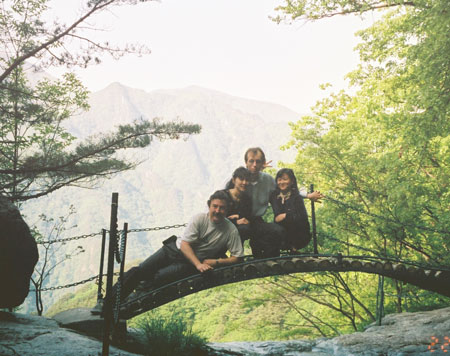
All of us.
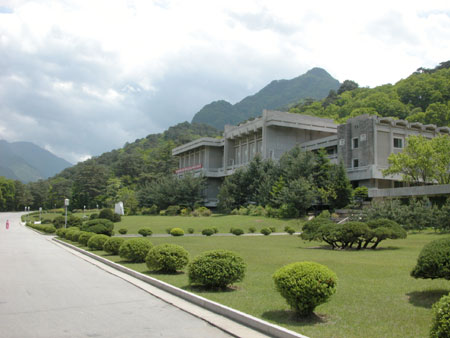
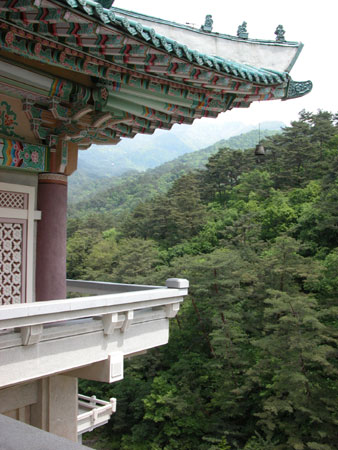
With about 200 large halls and the splendor the palace is comparable to the Hermitage (with the exception of the style of architecture and the modern building materials, of course).
No cameras are allowed (I think this is the only place in North Korea, where we could not take pictures
Inside are valuable presents given to Kim-Ir-Sen. I must note that all the exhibits are really interesting. That is, all items are either works of art or interesting in other ways (for instance a train car given to Kim-Ir-Sen by Stalin in 1946).
From modern Russia I noticed:
1. Painting of Vasilievskiy Island Point given by Putin.
2. A silver service given by Putin also.
3. A plate given by the Russian Foreign Intelligence Service.
Also there are rifles and other items given by Stalin, Khruschev, Brejnev
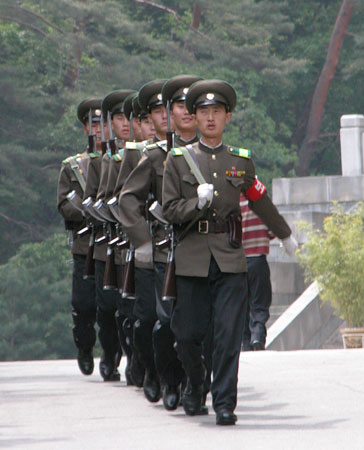
We were very impressed by a large landscape with trees and buildings, neatly carved out of ivory by Chinese craftsmen. In general, I would say, Chinese gave the most interesting and accurately crafted gifts.
Among the givers were also the leaders of South Korea, South Korean companies ?for example the president of Daewoo gave Kim-Ir-Sen a car.
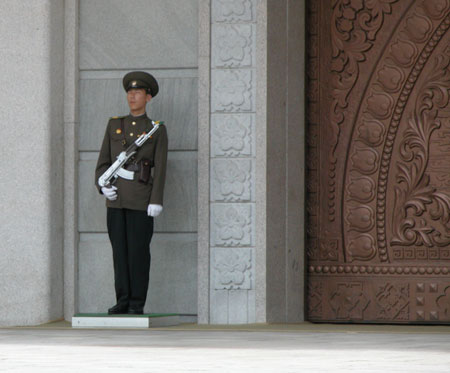
The palace guards.
Notice that the Kalashnikovs are nickel plated.
The doors are one-piece bronze, weighing several ton each. One can open them by hand (the guide gives out a special glove to pull on the handle
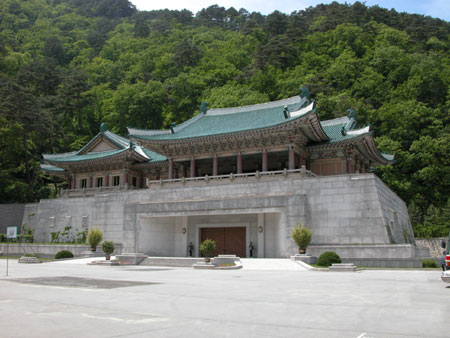
This is the second building, the presents to Kim-Chen-Ir. It is much more modest both outside and inside. It is also smaller.
Most striking is a wax statue of Kim-Ir-Sen in the middle of artificial meadow surrounded by birch trees with sky in the background. The tree leaves even move with the artificial wind coming from a fan. The lighting is well designed, and the whole thing looks real. I think it was also given by the Chinese.
One small thing to note: it뭩 strange, but I noticed that practically all the buildings in the country (regardless of their status and decor) have identical light switches
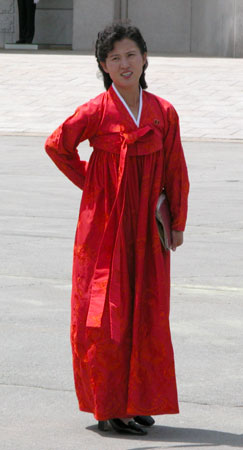
A local tour guide.
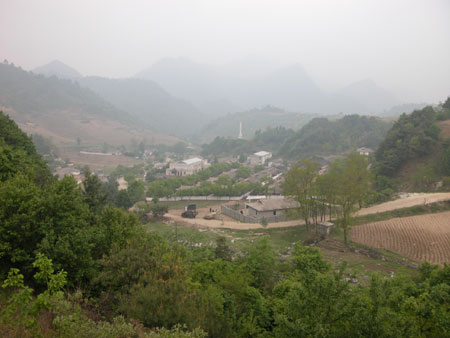
Here we asked the driver to stop the car and I took some pictures. This village doesn't look very well-being, there're some more decent. Also it's not so characteristic: buildings stands irregularly.
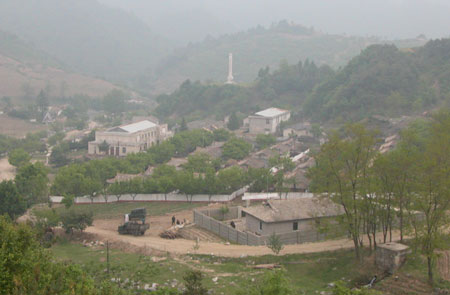
Obelisk" on a background - is a feature, necessary for all settlements. Usually the neutral, simple slogan is written there (a challenge to work and learn better and so on).
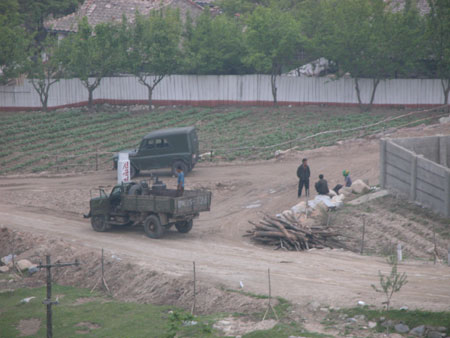
Machines typical for village - GAZ (probably made in Northern Korea, not in Russia) and a lorry - with gas generator.
This car works with firewood, but I have to underline, that it's NOT a steam machine, but GAS-generator (Usual internal combustion engine, just re-made). It's not gasoline, of course, so the max speed is about 20-30 km per hour.
The firewood (at the right) are prepared for lorry. They're put by portions into the can (is seen in the back of a lorry) and slowly burn there.
We've seen such machines about five times in general.
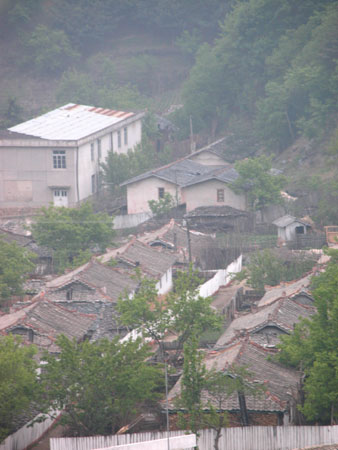
The roofs are usually made of tiles or something like that.
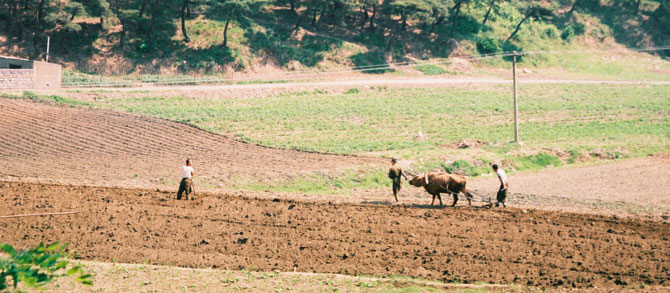
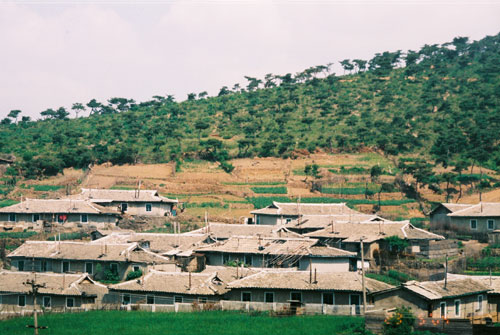
nd this is the more typical Northern Korea village.
Houses are identical, located by uniform group, usually in parallel or straight lines.
If mountains prevents, then houses locates by few groups on both sides of the mountain.
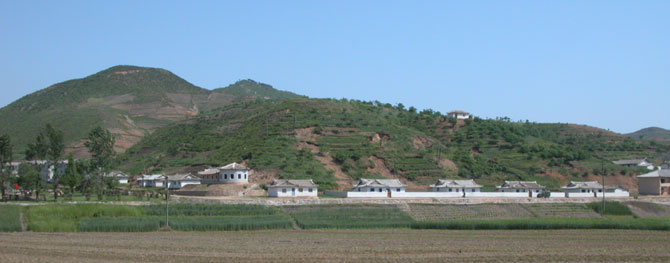
The one more curious moment - about cellular communication. It exists (not less than GSM), but for foreigners it does not operate (no roaming). More of that, the girls told us that it's forbidden to take the mobile phone into the country (on border it will be taken from you, on departure it'll be given back). But I have taken phone without questions, and have written about it to declarations, and on the way back the frontier-guard has seen it.
Certainly, it was not possible to speak by phone, but I knew the one curious thing: everywhere we've been (quite a big area) - the network of cellular communication also was everywhere, stably half of a scale (I shall remind - here's a hilly country). Though I did not see any base stations. Maybe, they mask them as mountains?
Not long ago I heard in Russian TV news, that mobile phones were taken away from Northern Korea people. Hah! They should've thought what they invent! How could any Korean have cellular phone, when for the sum which there's a mobile phone costs, here it's possible to live about a year? : Abundantly clear, that this service at the moment is only for militarians and officials of a decent level. And there's no point to take mobile phones from them (it's easier to turn off the base stations).
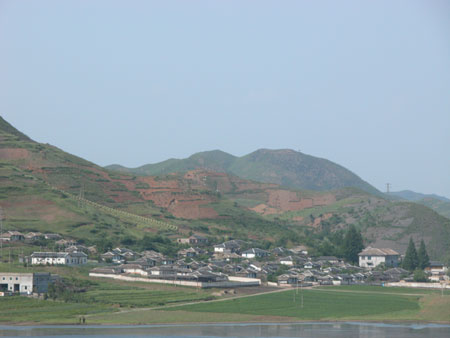
A notice: the houses in russian villages are usually decorated, decorations on the wicket-gates, fences, carved window-frames and so on. Although, the house can be leaned-over :
I didn't see anything like that in Korea. I mean, village houses are not decorated at all.
I've been told later, that south-korean villages look the same way as northern.
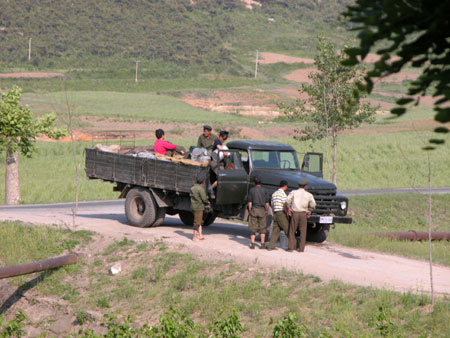
About a heating.
In Korea (and maybe, in the East in general) the traditional way of heating in the houses is not the same as in Russia. They don't install ovens. Near the house there is something like a hole where coal or fire wood is pawned. The warmed air goes through under the floor and heats the house. Probably, it is connected with tradition to sit on a floor. This system is still used. Not only in villages, but also in guide's cabin near any distant sightseeing.
What is not clear for me in this system - and how about an intoxication, a smoke and other?
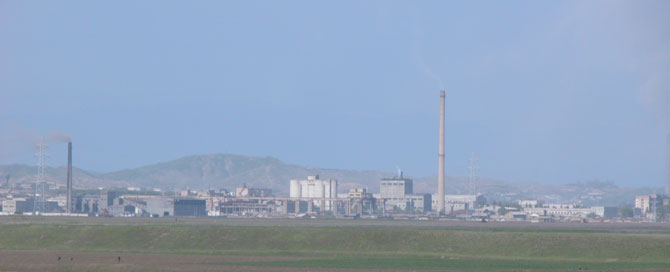
Probably, the cement factory
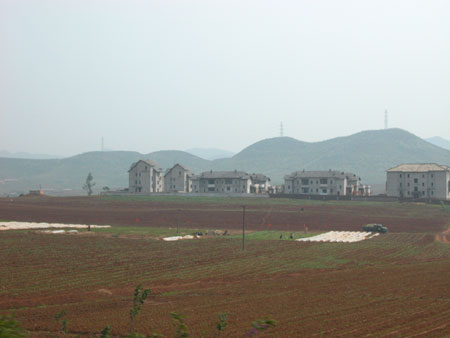
nd this is the modern settlement.
The structure is similar, but houses already more thorough. Moreover, want to admit, that in Russia such houses appears when the village grows to larger settlement. Here it is not like that. By it's size, it's still a village, just the houses are modern.
Under a polyethylene film - the rice grows
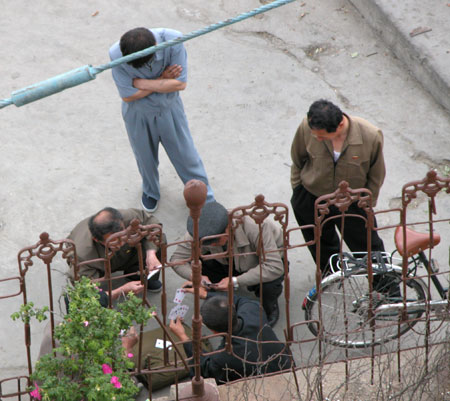
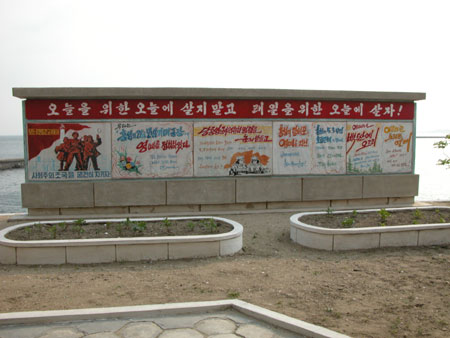
Evident propaganda
By the writing 106% it is possible to assume, that it is a question about exceeding the plan
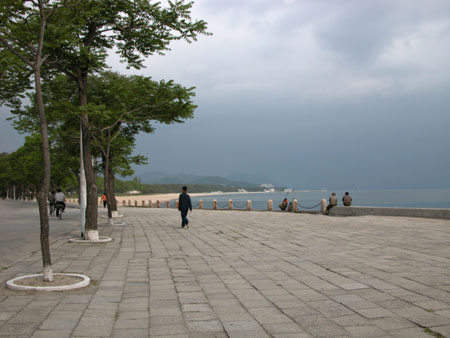
And here we went out without support and have decided to take a walk . At first we've walked along the embankment. (where is the electrified fence???)
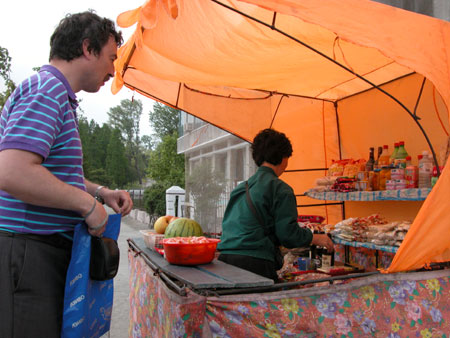
Alexey tries to buy some local bubblegums and other stuff?br />
From four standing near to each other cooperative kiosks the only one seller didn't want to talk to us. In her own will. She just pointedly turned away with very dissatisfied physiognomy. But we've had no problems with others, including the currency payments.
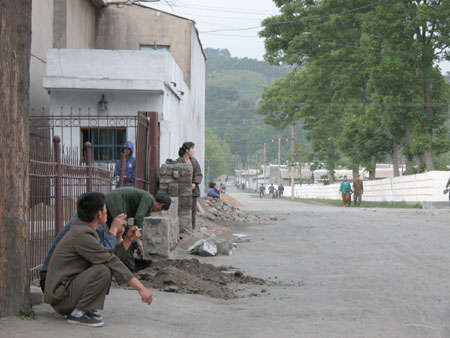
Here begins the ordinary village.
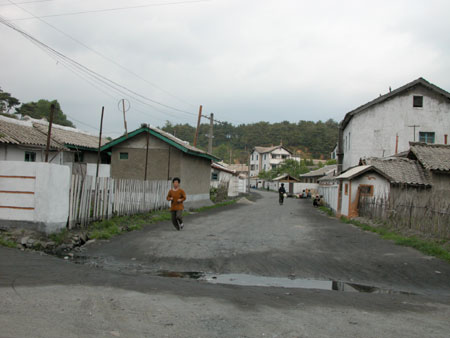
Basically, comparing to Russia, nothing really terrible.
But Europeans really have got nothing to do here
The population is friendly (the worst thing we've seen - the man just passed us by, pretending that does not notice us). Nobody importunes, nobody asks for money.
Just the kids at the embankment near the hotel tried to talk to us (they knew the only word - "OK" : )
They were completely satisfied with a candy.
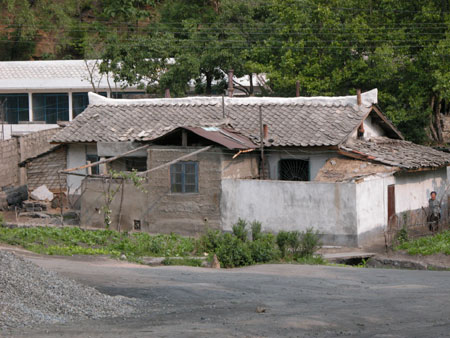
As I noticed before, houses are fenced by continuous fences, for neighbors and passers-by couldn't see what's going on inside. Actually, there's nothing special inside.
Alexey here continued to hunt for bubblegums. The local population did not object (here and there on the ground the pieces of a fabric with the fine goods laid.
Nobody protested to take dollars. But sometimes sellers ran away to ask neighbors. Also nobody haggled with us - we just changed bubblegums to 1 dollar banknotes in more or less reasonable parity
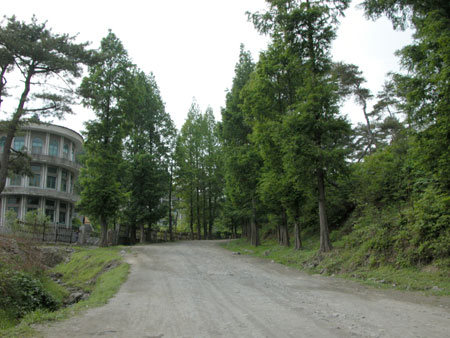
Somewhere there're more decent houses. Also the lots somewhere organized as in Russia - without continuous fences. But it's not characteristic.
The nature and landscapes - right here - looks like Leningrad region
Couple of ravines, pines, sand. The road is ordinary too.
Only, if to look narrowly, unknown plants come across, and those that are known, look slightly not so.
Here our small walk finished. We have returned to hotel, fairly having informed girls about our vile act
I think, at the moment in the places, where it's needed :, the general representation about us was already made. They realized that we're not seeking the pictures with rubbish heaps and ruins. So, they just winked at this.
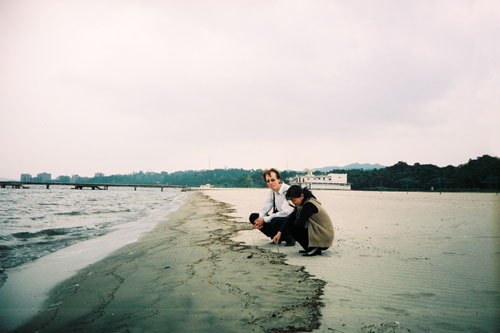
The coast, the beach and us.
This is the Japan sea. But Koreans (including southern) call it "Eastern Sea of Korea". About their relations with Japan I already wrote earlier.
It's still too cold to swim. But we've walked barefoot at the water.
Need to say that any visible restrictions on an output to coast are not observed (I read in one article before the trip, that a barbed wire is everywhere
The other thing, that there're almost no boats at the horizon. Maybe, it's not allowed to swim out by boats and fisherman-ships?
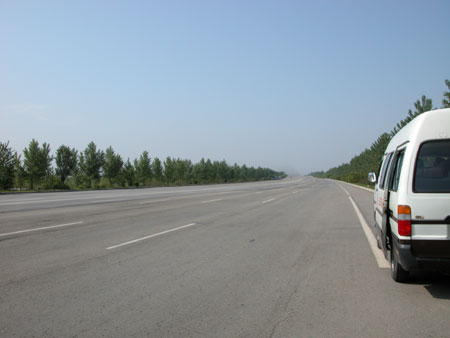
As I written before, some roads in Korea (main roads and also avenues in the capital) have a huge width.
The one more thing is - that here, just like in Russia, it's allowed to stand at the roadside, to sell mushrooms and berries. Although officially it's forbidden. But, anyway?/div>
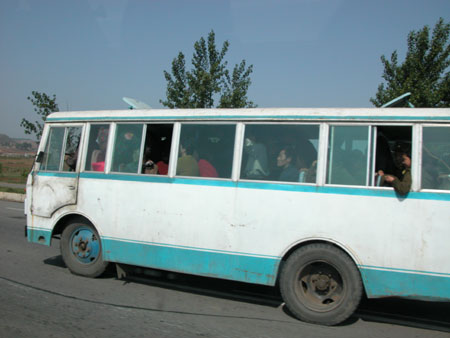
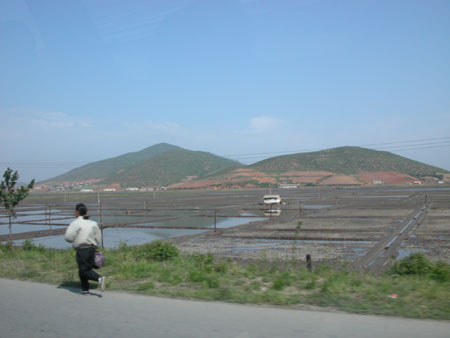
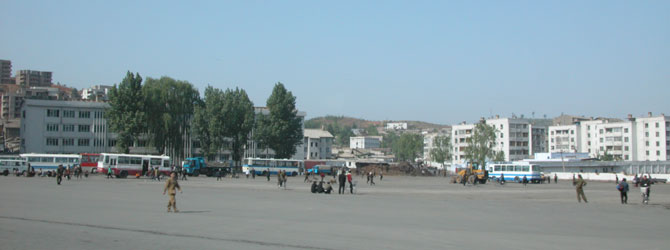
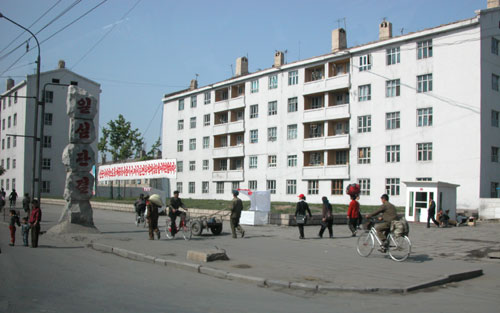
I think, that in old buildings the collective TV aerials were not foreseed, so the inhabitants had to solve this problem by theirselves.
Talking about TV broadcasting, it's needed to say that usually only 1-2 channels are available. The repertoire is modest: local films, Chinese or soviet movies. The news are regular. It's curious, that there're no video subjects in the news. Usually the announcer reads something or the static photos are shown.
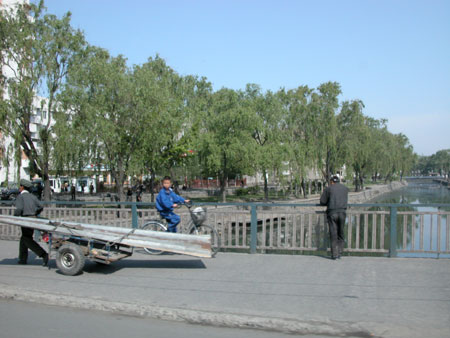
People carries different things, useful in household.
I've seen in Pyongyang the man, who carried a refrigerator (!) on the bike! Vertically! It has really impressed me!

The general dam view. Makes a strong impression!
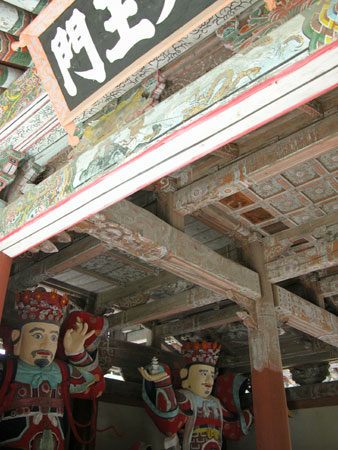
The temple was originally raised in 1042 and since then it's been burnt and re-built many times.
The quote from one of the sources about Buddha:
"According to Buddhist chronology the Buddha lived with 623 on 544 ?up to B.C. He was born in aristocratic family that ruled a small country on the border of Nepal and India. In his childhood he was protected . from the unpleasant parties of a surrounding life. When Gautama grown up, he realized that life is full of sorrow. He decided to help the people. At the age of 29 he left home and became a hermit. But soon he knew that killing of the flesh conducts to fading of the mind and gave up the asketism. At the age of 35 he realized that the truth is near. Gautama absorbed into meditation and spent there 4 or 7 weeks without food and sleep. As a result he has reached an enlightenment, i.e. became the Buddha, who knows all the laws of Universe. After that Buddha walked around the country about 45 years, preaching his doctrine. He died at the age of 80".
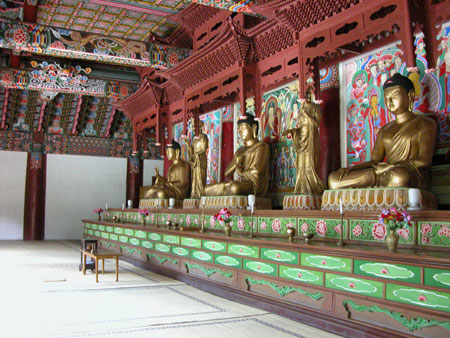
It's necessary to take off the shoes near the entrance. There're straw mats on the floor.
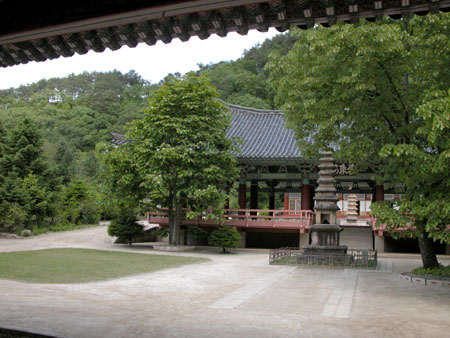
s I said before, during the war, the bombing of USA has destroyed most of historical buildings in the North. That's why it's very difficult to tell, what building is ancient, what is restored and re-built. I think, there're lots of new-built.
Anyway, they never say to tourists that "this building was re-built in some year?quot; - for clear reasons.
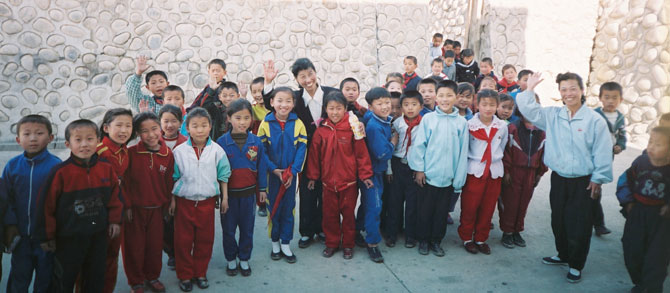
A group of children that we met, when we walked out of another sightseeing.
Of course, they didn't miss a chanse to pose at the camera

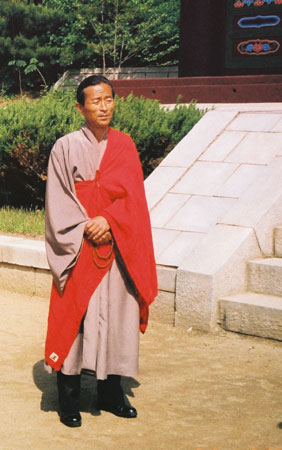
The duty monk in one of a monastries.
To all attributes, the monk is his post. He walks out to tourists and answer the questions. Like: " Whether themonks serve in army?" (" -Yes, they do") and so on. Actually, the politically grounded monk.
We asked, where do they take the food. The monk explained, that the state supplied'em with the food and they just grow different medicinal herbs.
Have a look at the boots
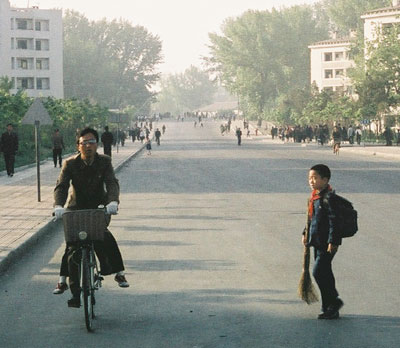
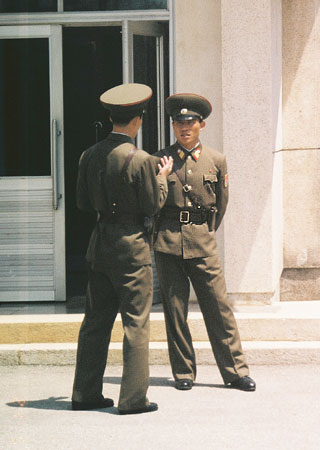
We drove from Keson to Pkhanmunjom village - about 8 km from Keson.
At the 300 m to the border (to demilitarized zone about 2 km wide) we were invited to rest in a small house. The frontier guard came to talk to us (with the help of translator).We had a small talk about politics. Basically, he asked the questions. Like these:
"I heard about president elections in Russia and that V.Putin is elected. Has he got the real people's support?"
"What is, to your mind, the most serious obstacle on the way to unite the Korea?"
Because we two answered in different ways, we asked the girls to translate the answer that they liked most
Then we wished the luck to each other and went back to the bus. The previous driver left us. The "comrade colonel" sat behind the wheel again and also two soldiers with machine guns and the frontier guard went with us. Five pics below you can see this frontier as a guide.
We've driven on the narrow road, surrounded with barbed wire. And soon we appeared on the spacious square with the view of Southern Korea.
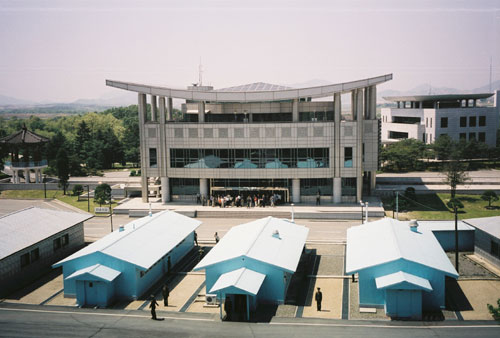
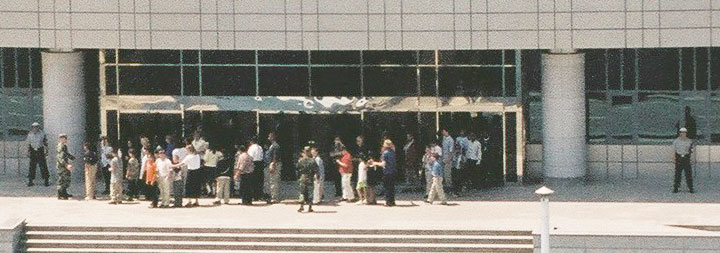
The man with megaphone in his hands came before them and started to tell the south-korean version of events during the war. We heard almost every word. Well?now I understand why we came here : Our proleader seemed to read our minds and has grinned silently, as if he wanted to say: "You see everything, I've nothing to add".
Later I've read in some western story about visit to Northern Korea these lines: "Down by the demarcation line, North Korean soldiers stood stiffly in dress uniform on one side, stared at by slouching South Korean troops in mirrored sunglasses on the other. From afar they looked like Russians and Americans..."
Looks like it's not our impression only. By the way, the American forces are still quartered in Southern Korea.
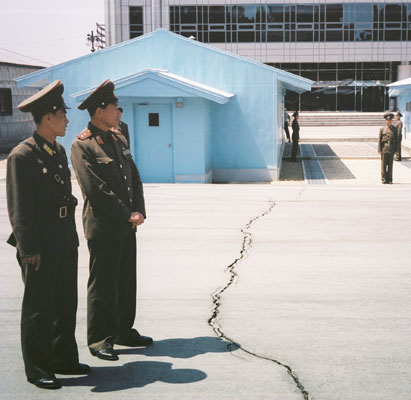
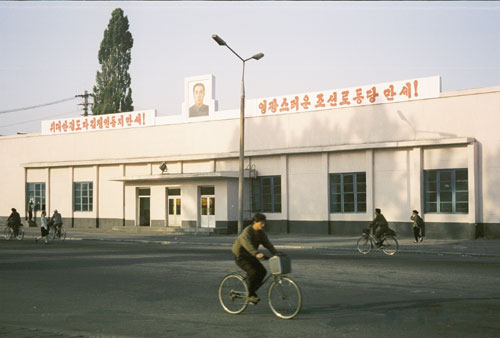

Actually, not a capital bus. The back wheels seems to be taken from a lorry 

This is not the rice, it's the evaporation of salt process.


It's not seen very well, but you can believe me, that there're lots of TV aerials on the roofs of the buildings.
I think, that in old buildings the collective TV aerials were not foreseed, so the inhabitants had to solve this problem by theirselves.
Talking about TV broadcasting, it's needed to say that usually only 1-2 channels are available. The repertoire is modest: local films, Chinese or soviet movies. The news are regular. It's curious, that there're no video subjects in the news. Usually the announcer reads something or the static photos are shown.

People carries different things, useful in household.
I've seen in Pyongyang the man, who carried a refrigerator (!) on the bike! Vertically! It has really impressed me!

The general dam view. Makes a strong impression!

The temple was originally raised in 1042 and since then it's been burnt and re-built many times.
The quote from one of the sources about Buddha:
"According to Buddhist chronology the Buddha lived with 623 on 544 ?up to B.C. He was born in aristocratic family that ruled a small country on the border of Nepal and India. In his childhood he was protected . from the unpleasant parties of a surrounding life. When Gautama grown up, he realized that life is full of sorrow. He decided to help the people. At the age of 29 he left home and became a hermit. But soon he knew that killing of the flesh conducts to fading of the mind and gave up the asketism. At the age of 35 he realized that the truth is near. Gautama absorbed into meditation and spent there 4 or 7 weeks without food and sleep. As a result he has reached an enlightenment, i.e. became the Buddha, who knows all the laws of Universe. After that Buddha walked around the country about 45 years, preaching his doctrine. He died at the age of 80".

It's necessary to take off the shoes near the entrance. There're straw mats on the floor.

s I said before, during the war, the bombing of USA has destroyed most of historical buildings in the North. That's why it's very difficult to tell, what building is ancient, what is restored and re-built. I think, there're lots of new-built.
Anyway, they never say to tourists that "this building was re-built in some year?quot; - for clear reasons.

A group of children that we met, when we walked out of another sightseeing.
Of course, they didn't miss a chanse to pose at the camera

The duty monk in one of a monastries.
To all attributes, the monk is his post. He walks out to tourists and answer the questions. Like: " Whether themonks serve in army?" (" -Yes, they do") and so on. Actually, the politically grounded monk.
We asked, where do they take the food. The monk explained, that the state supplied'em with the food and they just grow different medicinal herbs.
Have a look at the boots


We drove from Keson to Pkhanmunjom village - about 8 km from Keson.
At the 300 m to the border (to demilitarized zone about 2 km wide) we were invited to rest in a small house. The frontier guard came to talk to us (with the help of translator).We had a small talk about politics. Basically, he asked the questions. Like these:
"I heard about president elections in Russia and that V.Putin is elected. Has he got the real people's support?"
"What is, to your mind, the most serious obstacle on the way to unite the Korea?"
Because we two answered in different ways, we asked the girls to translate the answer that they liked most
Then we wished the luck to each other and went back to the bus. The previous driver left us. The "comrade colonel" sat behind the wheel again and also two soldiers with machine guns and the frontier guard went with us. Five pics below you can see this frontier as a guide.
We've driven on the narrow road, surrounded with barbed wire. And soon we appeared on the spacious square with the view of Southern Korea.


The man with megaphone in his hands came before them and started to tell the south-korean version of events during the war. We heard almost every word. Well?now I understand why we came here : Our proleader seemed to read our minds and has grinned silently, as if he wanted to say: "You see everything, I've nothing to add".
Later I've read in some western story about visit to Northern Korea these lines: "Down by the demarcation line, North Korean soldiers stood stiffly in dress uniform on one side, stared at by slouching South Korean troops in mirrored sunglasses on the other. From afar they looked like Russians and Americans..."
Looks like it's not our impression only. By the way, the American forces are still quartered in Southern Korea.


 1
1







댓글 [6]
sgtbae | 2006-06-17 | 추천 0
권선동 | 2006-06-16 | 추천 0
라이더맨 | 2006-06-16 | 추천 0
아름다운토마호크 | 2006-06-16 | 추천 0
북녘의미소 | 2006-06-15 | 추천 0
minki | 2006-06-15 | 추천 0